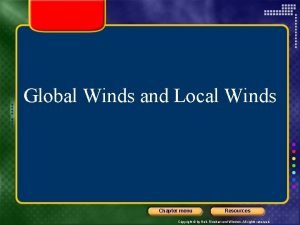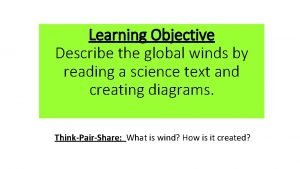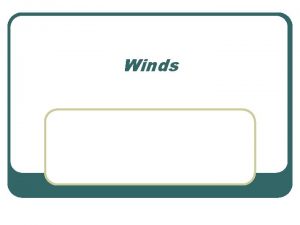Winds in the Venusian Atmosphere Elliot Young Mark





- Slides: 5

Winds in the Venusian Atmosphere Elliot Young & Mark Bullock 1 1 Southwest Research Institute, Boulder, CO

Why study the winds in the atmosphere of Venus? The theory of Venus’ retrograde superrotating atmosphere continues to be an active topic that is limited by the paucity of direct observations. While the solid surface takes 243 earth-days to complete a rotation, the bulk of Venus’ atmosphere whips around in only 6 days. The key to understanding Venus’ superrotation is to identify how angular momentum is transferred to the atmosphere. Ideally, this could be achieved by knowing the winds throughout Venus’ atmosphere as a function of time. However, direct wind data are available only from the tracking of a few probes that have descended into Venus’ atmosphere at a handful of latitudes and local times of day. As a proxy for middle atmosphere winds on Venus, we observe cloud motions. The technique we use relies on the fact that clouds in the lower cloud deck (around 48 - 51 km altitude) block thermal radiation from the surface and show up as dark silhouettes on the night side of Venus. Cloud silhouettes aren't the same as actual wind vectors, but they may be sufficient to see large-scale phenomena such as Hadley cells, zonal winds, and rotating storm systems.

Venus is typically observable for an hour or two during morning or evening twilight. To get a longer time baseline, Young and Bullock enlisted the help of observers at sites around the world, including the Apache Point Observatory, Nordic Optical Telescope, Lowell Observatory, the Anglo-Australian Telescope, and observatories in India to provide a well-sampled sequence of images over a baseline of one week. Previous observers, led by Dave Crisp at JPL, imaged the nightside of Venus with a similar network of observatories during the Galileo spacecraft flyby of Venus in 1991. We have been fortunate in getting very good seeing conditions at the IRTF which may allow us to detect phenomena that were not observable previously. The next slide shows a sequence of images obtained over a 3 hour time period on July 13, 2004. The seeing was 0. 4 arcsec at K at the start of the sequence. The rotation of Venus's atmosphere is pretty evident -- remember that the solid surface of the planet rotates every 224 days!

1 2 3 4

Mercator projection showing details of the clouds.







